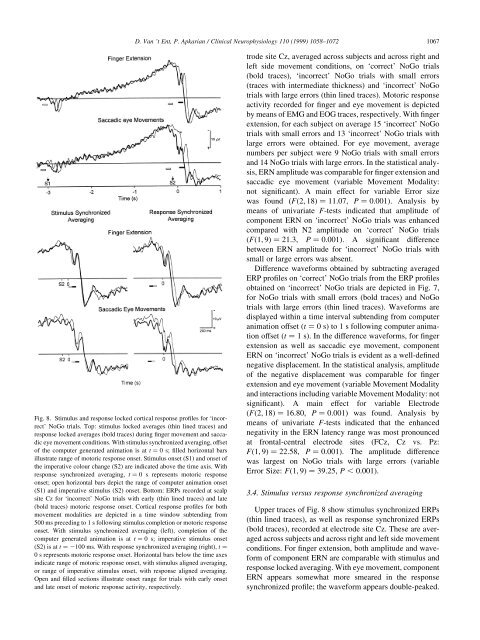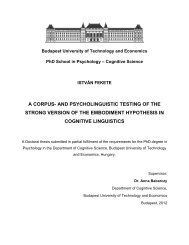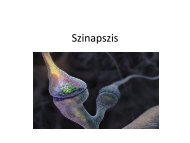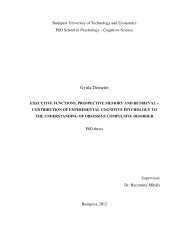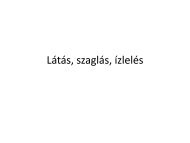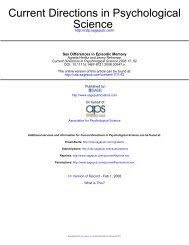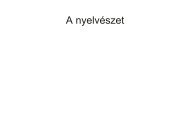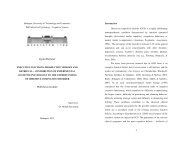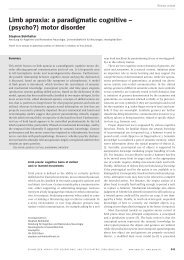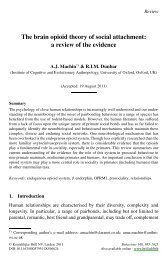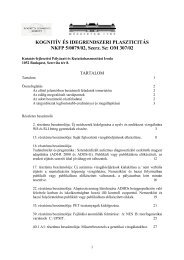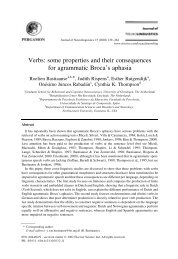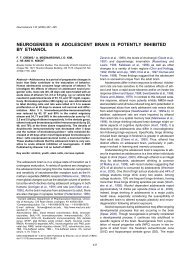Motoric response inhibition in finger movement and saccadic eye ...
Motoric response inhibition in finger movement and saccadic eye ...
Motoric response inhibition in finger movement and saccadic eye ...
Create successful ePaper yourself
Turn your PDF publications into a flip-book with our unique Google optimized e-Paper software.
Fig. 8. Stimulus <strong>and</strong> <strong>response</strong> locked cortical <strong>response</strong> pro®les for `<strong>in</strong>correct'<br />
NoGo trials. Top: stimulus locked averages (th<strong>in</strong> l<strong>in</strong>ed traces) <strong>and</strong><br />
<strong>response</strong> locked averages (bold traces) dur<strong>in</strong>g ®nger <strong>movement</strong> <strong>and</strong> <strong>saccadic</strong><br />
<strong>eye</strong> <strong>movement</strong> conditions. With stimulus synchronized averag<strong>in</strong>g, offset<br />
of the computer generated animation is at t ˆ 0 s; ®lled horizontal bars<br />
illustrate range of motoric <strong>response</strong> onset. Stimulus onset (S1) <strong>and</strong> onset of<br />
the imperative colour change (S2) are <strong>in</strong>dicated above the time axis. With<br />
<strong>response</strong> synchronized averag<strong>in</strong>g, t ˆ 0 s represents motoric <strong>response</strong><br />
onset; open horizontal bars depict the range of computer animation onset<br />
(S1) <strong>and</strong> imperative stimulus (S2) onset. Bottom: ERPs recorded at scalp<br />
site Cz for `<strong>in</strong>correct' NoGo trials with early (th<strong>in</strong> l<strong>in</strong>ed traces) <strong>and</strong> late<br />
(bold traces) motoric <strong>response</strong> onset. Cortical <strong>response</strong> pro®les for both<br />
<strong>movement</strong> modalities are depicted <strong>in</strong> a time w<strong>in</strong>dow subtend<strong>in</strong>g from<br />
500 ms preced<strong>in</strong>g to 1 s follow<strong>in</strong>g stimulus completion or motoric <strong>response</strong><br />
onset. With stimulus synchronized averag<strong>in</strong>g (left), completion of the<br />
computer generated animation is at t ˆ 0 s; imperative stimulus onset<br />
(S2) is at t ˆ 2100 ms. With <strong>response</strong> synchronized averag<strong>in</strong>g (right), t ˆ<br />
0 s represents motoric <strong>response</strong> onset. Horizontal bars below the time axes<br />
<strong>in</strong>dicate range of motoric <strong>response</strong> onset, with stimulus aligned averag<strong>in</strong>g,<br />
or range of imperative stimulus onset, with <strong>response</strong> aligned averag<strong>in</strong>g.<br />
Open <strong>and</strong> ®lled sections illustrate onset range for trials with early onset<br />
<strong>and</strong> late onset of motoric <strong>response</strong> activity, respectively.<br />
D. Van 't Ent, P. Apkarian / Cl<strong>in</strong>ical Neurophysiology 110 (1999) 1058±1072 1067<br />
trode site Cz, averaged across subjects <strong>and</strong> across right <strong>and</strong><br />
left side <strong>movement</strong> conditions, on `correct' NoGo trials<br />
(bold traces), `<strong>in</strong>correct' NoGo trials with small errors<br />
(traces with <strong>in</strong>termediate thickness) <strong>and</strong> `<strong>in</strong>correct' NoGo<br />
trials with large errors (th<strong>in</strong> l<strong>in</strong>ed traces). <strong>Motoric</strong> <strong>response</strong><br />
activity recorded for ®nger <strong>and</strong> <strong>eye</strong> <strong>movement</strong> is depicted<br />
by means of EMG <strong>and</strong> EOG traces, respectively. With ®nger<br />
extension, for each subject on average 15 `<strong>in</strong>correct' NoGo<br />
trials with small errors <strong>and</strong> 13 `<strong>in</strong>correct' NoGo trials with<br />
large errors were obta<strong>in</strong>ed. For <strong>eye</strong> <strong>movement</strong>, average<br />
numbers per subject were 9 NoGo trials with small errors<br />
<strong>and</strong> 14 NoGo trials with large errors. In the statistical analysis,<br />
ERN amplitude was comparable for ®nger extension <strong>and</strong><br />
<strong>saccadic</strong> <strong>eye</strong> <strong>movement</strong> (variable Movement Modality:<br />
not signi®cant). A ma<strong>in</strong> effect for variable Error size<br />
was found (F…2; 18† ˆ11:07, P ˆ 0:001). Analysis by<br />
means of univariate F-tests <strong>in</strong>dicated that amplitude of<br />
component ERN on `<strong>in</strong>correct' NoGo trials was enhanced<br />
compared with N2 amplitude on `correct' NoGo trials<br />
(F…1; 9† ˆ21:3, P ˆ 0:001). A signi®cant difference<br />
between ERN amplitude for `<strong>in</strong>correct' NoGo trials with<br />
small or large errors was absent.<br />
Difference waveforms obta<strong>in</strong>ed by subtract<strong>in</strong>g averaged<br />
ERP pro®les on `correct' NoGo trials from the ERP pro®les<br />
obta<strong>in</strong>ed on `<strong>in</strong>correct' NoGo trials are depicted <strong>in</strong> Fig. 7,<br />
for NoGo trials with small errors (bold traces) <strong>and</strong> NoGo<br />
trials with large errors (th<strong>in</strong> l<strong>in</strong>ed traces). Waveforms are<br />
displayed with<strong>in</strong> a time <strong>in</strong>terval subtend<strong>in</strong>g from computer<br />
animation offset (t ˆ 0 s) to 1 s follow<strong>in</strong>g computer animation<br />
offset (t ˆ 1 s). In the difference waveforms, for ®nger<br />
extension as well as <strong>saccadic</strong> <strong>eye</strong> <strong>movement</strong>, component<br />
ERN on `<strong>in</strong>correct' NoGo trials is evident as a well-de®ned<br />
negative displacement. In the statistical analysis, amplitude<br />
of the negative displacement was comparable for ®nger<br />
extension <strong>and</strong> <strong>eye</strong> <strong>movement</strong> (variable Movement Modality<br />
<strong>and</strong> <strong>in</strong>teractions <strong>in</strong>clud<strong>in</strong>g variable Movement Modality: not<br />
signi®cant). A ma<strong>in</strong> effect for variable Electrode<br />
(F…2; 18† ˆ16:80, P ˆ 0:001) was found. Analysis by<br />
means of univariate F-tests <strong>in</strong>dicated that the enhanced<br />
negativity <strong>in</strong> the ERN latency range was most pronounced<br />
at frontal-central electrode sites (FCz, Cz vs. Pz:<br />
F…1; 9† ˆ22:58, P ˆ 0:001). The amplitude difference<br />
was largest on NoGo trials with large errors (variable<br />
Error Size: F…1; 9† ˆ39:25, P , 0:001).<br />
3.4. Stimulus versus <strong>response</strong> synchronized averag<strong>in</strong>g<br />
Upper traces of Fig. 8 show stimulus synchronized ERPs<br />
(th<strong>in</strong> l<strong>in</strong>ed traces), as well as <strong>response</strong> synchronized ERPs<br />
(bold traces), recorded at electrode site Cz. These are averaged<br />
across subjects <strong>and</strong> across right <strong>and</strong> left side <strong>movement</strong><br />
conditions. For ®nger extension, both amplitude <strong>and</strong> waveform<br />
of component ERN are comparable with stimulus <strong>and</strong><br />
<strong>response</strong> locked averag<strong>in</strong>g. With <strong>eye</strong> <strong>movement</strong>, component<br />
ERN appears somewhat more smeared <strong>in</strong> the <strong>response</strong><br />
synchronized pro®le; the waveform appears double-peaked.


